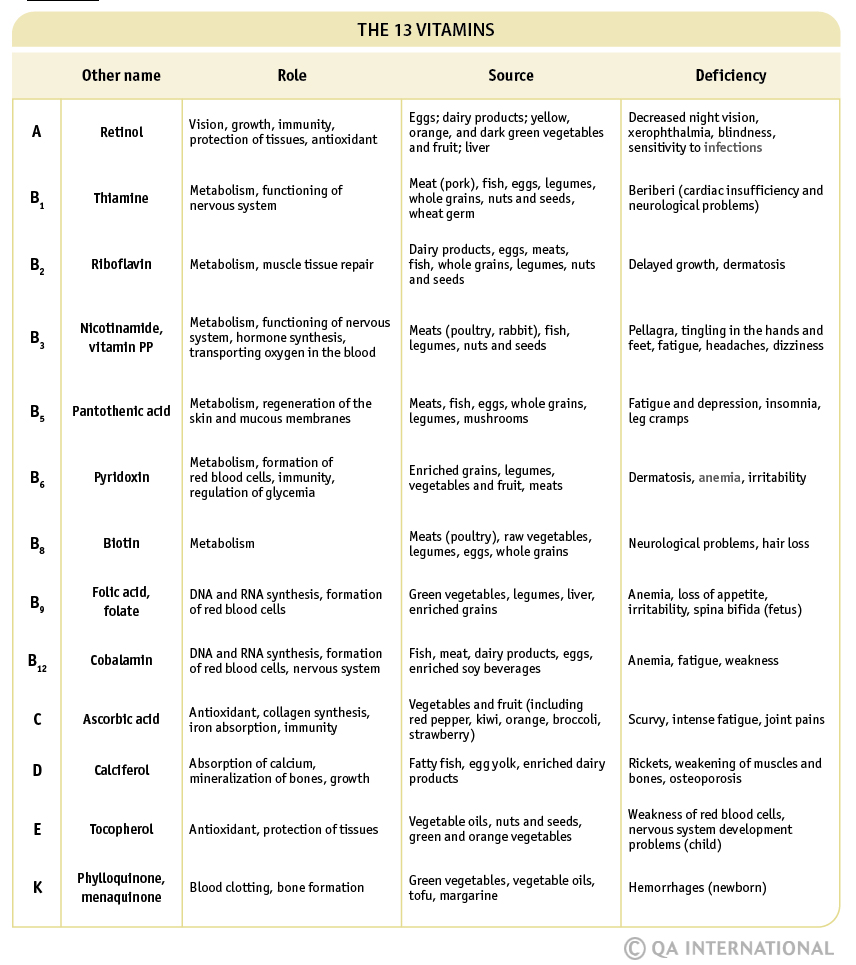
Nutrients: essential to good health! (1st part)
The various nutrients (carbohydrates, proteins, fats, minerals, vitamins) are distributed in four major food groups: grain products, vegetables and fruit, milk and milk alternatives, and meat and meat alternatives.
Carbohydrates
Carbohydrates constitute the body's main source of energy. They alone should constitute more than half of the daily recommended calorie requirement. Carbohydrates are primarily present in foods of plant origin such as grain products, legumes, vegetables, and fruit. A distinction is made between simple carbohydrates, complex carbohydrates and dietary fiber. Complex carbohydrates and dietary fiber are particularly beneficial for the body and should therefore be favored in a balanced diet.
Simple carbohydrates
Simple carbohydrates are assimilated by the body in very little time because they are digested quickly. They therefore constitute an immediately usable source of energy and are particularly effective in the context of an intense effort. However, certain simple carbohydrates, such as sucrose (or saccharose) should be consumed in moderation because excesses promote obesity and type 2 diabetes. The principal simple carbohydrates are glucose, fructose, sucrose, lactose, and galactose. They are present in milk, corn, honey, and fruit, but particularly (and often in excessive quantity) in baked goods, candy, fruit juices, and carbonated beverages, in the form of white sugar, light and dark brown sugar, corn syrup, or molasses.
Complex carbohydrates
Complex carbohydrates, also called polysaccharides, are formed by a grouping of simple carbohydrates. They are assimilated more slowly by the body and have less harmful effects on the health than simple carbohydrates. The principal complex carbohydrates are starch and glycogen. Starch, of plant origin, comes from starchy foods such as grains, bread, pasta, rice, corn, legumes, and potatoes. Glycogen, of animal origin, is present in trace form in red meat.
Dietary fiber
Dietary fiber consists of complex carbohydrates of plant origin that cannot be absorbed, that is, cannot be digested. Cellulose, hemicellulose, pectin, and mucilage are the main dietary fibers. They come from whole grains, legumes, vegetables, and fruit. Dietary fiber is particularly beneficial for health because it forms a system that retains water. The fibers limit the absorption of certain substances such as cholesterol and produce a feeling of fullness, thus contributing in fighting against obesity and certain cardiovascular diseases. They also increase the volume of fecal matter and soften it, which facilitates its transit and reduces the risks of hemorrhoids, anal fissures, diverticulosis, and colorectal cancer.
Fats
Fats are particularly represented by fatty acids and cholesterol. The former are present in numerous foods such as oils, butter, margarine, meat, fish, eggs, dairy products, nuts, and seeds, while cholesterol is present only in products of animal origin. Lipids are stored in the fatty tissue, where they provide energy storage and thermal insulation. Certain dietary lipids increase the risk of developing cardiovascular disease or cancer; others play a protective role.
Fatty acid
A distinction is made between saturated and unsaturated fatty acids. Unsaturated fatty acids are present in plant oils (olive, canola, corn, sunflower, walnut, soy oils, etc.), avocados, fatty fish (salmon, mackerel, smelt, herring, and trout) as well as in seeds and nuts (flax, sunflower, walnut, cashews, pecans, almonds, peanuts, etc.). If excesses are avoided, they generally have a beneficial effect on the health by reducing the blood cholesterol level. As for saturated fatty acids, they come primarily from animal fats (butter, eggs, meat, processed meat products, milk, cheese). Some plant oils contain them too, such as palm and coconut oil. Consumed in excess, saturated fatty acids increase the blood cholesterol level and the risk of cardiovascular diseases, as do trans-fatty acids, a category of unsaturated fatty acids present primarily in industrial foods (pastries, fried goods).
Cholesterol
Cholesterol is a lipid naturally produced by the body, specifically by the liver. It enters into the composition of cellular membranes and several hormones. It is transported from the liver to the cells by blood proteins. Cholesterol that comes from food may, in certain cases, be added to that which is produced by the body and contribute to the increase in the blood cholesterol level. Excess cholesterol tends to deposit on the artery walls, thus increasing the risk of cardiovascular disease.
Omega 3s
Omega 3s are unsaturated essential fatty acids that have a protective effect against cardiovascular diseases and inflammatory diseases such as arthritis. They also play a role in the proper functioning of the nervous system, specifically the brain. Omega 3s are present in certain oils (canola, wheat germ, soy) and in nuts and seeds (flax, hemp, pumpkin). They are also present in algae and fatty fish (salmon, herring, sardines, mackerel, anchovies) and their consumption is particularly beneficial. Due to our dietary habits, the minimum recommended daily requirements are rarely achieved.
Vitamins
Vitamins, 13 in number, are present in very small quantities in the body, but they are indispensable for its functioning. They play a role in numerous functions: metabolism, cellular division, growth, coagulation, etc. With the exceptions of Vitamins B3 and D, which can be synthesized by the body under certain conditions, vitamins must be obtained from food. Any deficiency will result in health problems, which can sometimes be severe.

Also see:
In the Visual Dictionary:
- "Human being" section
- "Food and kitchen" section
In the encyclopedic capsules :
- Nutrients: essential to good health! (2nd part)
- A balanced diet
- A Spring detox in your plate
- Hygiene and the prevention of infections
- The kiwi fruit: love it tender!
- Fish: from ocean to our plate
- Gastroenteritis, when food makes you sick
- Corn, the sun plant
- The onion
- Cabbage
- The chile pepper
- Eggplant
- The squash
- The beet: life in colors!
- Edible mushrooms: a treat you shouldn’t fear!
- Pasta
- Nuts and seeds
- The chestnut
- The coconut: hard head, soft heart!
In the ikonet games:




